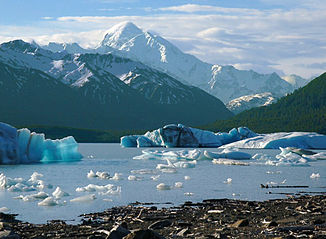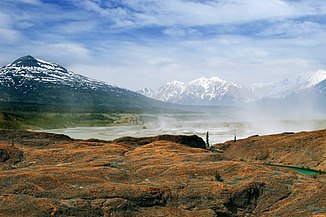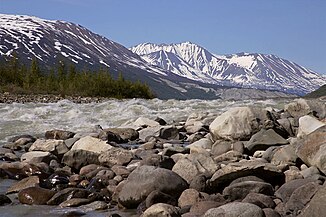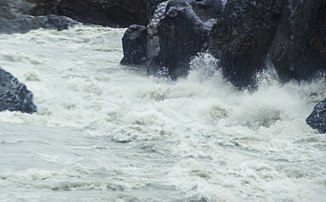Alsek River
| Alsek River | ||
|
The Alsek River flows at the foot of Mount Fairweather , ( 4663 m ), the Alsek Lake (Alaska) |
||
| Data | ||
| Water code | US : 1420073 | |
| location |
Yukon , British Columbia (Canada), Alaska (USA) |
|
| River system | Alsek River | |
| Confluence of |
Dezadeash River and Kaskawulsh River in Kluane National Park 60 ° 38 ′ 46 ″ N , 137 ° 48 ′ 26 ″ W |
|
| Source height | 550 m | |
| muzzle | 80 km southeast of Yakutat in the Dry Bay ( Gulf of Alaska ) Coordinates: 59 ° 11 '5 " N , 138 ° 25' 50" W 59 ° 11 '5 " N , 138 ° 25' 50" W |
|
| Mouth height | 0 m | |
| Height difference | 550 m | |
| Bottom slope | approx. 2.2 ‰ | |
| length | approx. 250 km (385 km with source rivers) |
|
| Catchment area | approx. 28,500 km² (24 km above the mouth) | |
| Discharge at the gauge above Bates River A Eo : 16,200 km² |
MQ 1974/2012 Mq 1974/2012 |
230 m³ / s 14.2 l / (s km²) |
| Discharge at the gauge below Tatshenshini A Eo : 28,500 km² Location: 68 km above the mouth |
MQ 1993/2011 Mq 1993/2011 |
892 m³ / s 31.3 l / (s km²) |
| Discharge at the Dry Bay A Eo gauge : 28,500 km² Location: 24 km above the estuary |
MQ 2012/2016 Mq 2012/2016 |
1318 m³ / s 46.2 l / (s km²) |
| Left tributaries | Bates River , Tatshenshini River | |
| Right tributaries | Lowell Glacier , Fisher Glacier , Tweedsmuir Glacier | |
| Flowing lakes | Lowell Lake , Alsek Lake | |
|
Alsek River and Tatshenshini River |
||
|
Sandstorm on the upper reaches |
||
|
The end of the Turnback Canyon |
||
|
Great water force, hardly any blocking |
||
|
In the Turnback Canyon |
||
The Alsek River is a North American wild river that flows from the Canadian Yukon via British Columbia to Alaska . Because of its scenic diversity, it is considered one of the most spectacular rivers in North America, but with the Turnback Canyon , its key point , also one of the most dangerous.
history
The Alsek was settled by Tlingit , but was limited to the lower reaches of the river. Its name, Alseck , comes from their language , which means something like “space to rest”. Its valley offered little appeal as a habitat, but continued through the Tatshenshini Valley , a historic trade route from the Gulf of Alaska inland to the Yukon Valley . The middle course was also avoided by the natives.
In 1725, a tidal wave poured through the Alsektal after the Lowell Glacier dammed the river and the ice barrier suddenly broke. The washed away settlements were rebuilt in the decades that followed, but the drama repeated itself on an even greater scale.
Over the years, a lake hundreds of square kilometers in size and eighty meters deep was created. Everything was under water beyond Haines Junction . When the glacier could no longer withstand the water pressure, the natural disaster occurred in 1850. A monstrous wall of water, interspersed with ice and rubble, shot down into the valley and tore everything away with it, 200 km into the Pacific. Only the traditional tribal stories of the Tlingit still tell of the settlements and people who were destroyed by the tidal wave. The traces of the reservoir are omnipresent on the upper reaches. Today, high on the mountain slopes north of the Lowell Glacier, you can see the erosion caused by the waves of the lake at that time. The wind still blows its sediment deposits through the wide valley and transports them to huge sand dunes.
It was not until the 1970s that a small summer settlement for catching salmon emerged again in the mouth of the Dry Bay . With the increase in rafting tourism in the 1990s, a ranger station was built and, since the only way to leave the Alsek is by plane, a grass runway was built.
geography
The Alsek River is created by the confluence of the Dezadeash River and Kaskawulsh River about 30 kilometers southwest of Haines Junction. It flows through the Elias chain , which forms part of the North American coastal mountains, and flows after 265 kilometers into Dry Bay, a bay in the Gulf of Alaska.
Its course can be divided into three opposing sections. The upper course meanders with innumerable arms in a wide valley with gravel banks, sand dunes and arctic vegetation. At river km 49, the Lowell Glacier dams the river. The middle course begins below. The valley becomes barren and narrow, the water faster, the mountains steeper and higher. Shortly after the Tweedsmuir Glacier calves into the Alsek River , the Turnback Canyon begins. A twelve kilometer long gorge, so rapid that it even blocks the ascent of the king salmon . At the beginning of the lower reaches, at river kilometer 186, the Tatshenshini flows. The mountains recede, the valley and river widen. The Alsek is now a sedate stream, crosses Alsek Lake , picks up iceberg cargo again, and heads towards the Pacific between dark green forests.
In 2016, global warming created a canyon near the Kaskawulsh Glacier , which diverted the water that otherwise flowed into the Slims River into the Alsek River. Since then the river has carried many times more water.
environment
natural reserve
North America's only river that runs its entire length in a nature reserve is the Alsek River. In the Yukon Territory, it has been part of the Canadian Heritage Rivers System in Kluane National Park since February 1986 . In British Columbia it flows through the Tatshenshini-Alsek Nature Reserve and in Alaska (USA) through the Glacier Bay National Park . All three parks, together with the Wrangell St. Elias National Park , make up a 9 million hectare nature reserve, half of which is covered by ice, making it the largest glacier area outside the poles. This international national park community has been on the list of UNESCO World Natural Heritage Sites since 1994 .
The Canadian people resolutely opposed the attempt by the mining industry to mine suspected copper deposits at Windy Craggy Mountain .
fauna
Bears are the secret rulers on the Alsek. The largest grizzly population (Ursus arctos horribilis) on earth with around 600 animals lives here . The elk (Alces alces) prefers the upper reaches of the river, where water-rich tundra characterizes the landscape. The Mountain Goat , also Alaska Mountain Goat (Oreamnos americanus) , populated the Goatheard Mountain and the mountains east of Lake Lowell in large herds. During the salmon migration, bald eagles (Haliaeetus leucocephalus) hunt along the lower reaches and nest in the hundreds on the wooded shores between Alsek Lake and Dry Bay. Seals (Phoca vitulina) populate the last kilometers of the river, from the last rapids onwards .
flora
The plant cover in the subalpine area, where no forest growth is possible due to the cold climate, presents itself as a heathland. Dwarf willow (Salix serpyllifolia) and dwarf birch (Betula nana) grow on the shoreline . The Alsek Pass is one of only two occurrences of Siberian cottongrass (Eriophorum callitrix) in America. From Alsek Lake to its mouth in the Pacific, the river is lined with coastal forest with Canadian hemlock (Tsuga canadensis) and Sitka spruce (Picea sitchensis) , which can also be found right by the sea due to its tolerance to sea salt.
wild Water
There is no asphalt or concrete along the Alsek River. Therefore, apart from the first few kilometers, which can be reached on foot, the river can only be experienced by boat. Suitable: Raft or kayak . The degree of difficulty is WW II over long stretches , some flood stretches with WW III + , but the low temperature of the water should not be underestimated. Kayakers must therefore be experienced, guided rafting tours are also possible for those inexperienced.
Driving the 12 kilometer long Turnback Canyon is life-threatening. It may only be considered by experienced specialists, under optimal conditions and after careful study. The rangers of Kluane Park expressly warn against this, as fatal accidents happen again and again. The gorge can be carried around - laboriously - or a helicopter transfer can be arranged before take-off.
The number of annual visits is strictly limited, a large part of which is assigned to commercial rafting companies. There is a waiting list. A backcountry permit fee of $ 9.80 is currently due per person per night . The rangers of the Kluane Park can advise on other regulations (bear-safe food containers, fire bowls, etc.).
Travel history
The first ascent was made by Walt Blackadar single-handedly in 1971 . He then said: "... I'll never go back, not for $ 50,000, not for all tea in China" (I would never repeat that, not for 50,000 dollars, not for all tea in China).
The next attempt by a French expedition ended fatally in the Turnback Canyon . The survivors had to be removed by helicopter.
The second visit took place in 1981 by the German paddler legend Hans Memminger with Mike Hierl and Claus Streckmann . During their 25-day expedition, they made the film River of Grizzlys and Glaciers .
In 1983 the Austrians Uschi Breithofer, Wolfgang and Michael Ott made the third and first ascent of the Turnback Canyon with a raft. You made the award-winning film White Water, Blue Ice .
literature
- Russ Lyman, Joe Ordonez, Mike Speaks: The Complete Guide to the Tatshenshini River including the Upper Alsek River . Cloudburst Productions, Haines, Alaska 2000, ISBN 0-9728122-1-0 (English).
- William R. Newcott, Jay Dickman: Rivers of Conflict - Tatshenshini-Alsek Wilderness Park in: National Geographic Vol. 185, No.2 - February 1994
Web links
- Alsek River . In: BC Geographical Names (English)
- American Whitewater Whitewater Info: Alsek (English)
- Alsek River , extensive German-language river description.
Individual evidence
- ^ Alsek River in the Geographic Names Information System of the United States Geological Survey
- ↑ a b USGS 15129120 ALSEK R AT DRY BAY NR YAKUTAT AK
- ↑ Water Survey of Canada: Station 08AB001
- ↑ Water Survey of Canada: Station 08AB002
- ↑ River piracy and drainage basin reorganization led by climate-driven glacier retrea. Nature , April 17, 2017. doi: 10.1038 / NGEO2932
- ↑ a b Kluane National Park and Reserve
- ↑ Tatshenshini-Alsek National Park
- ^ Glacier Bay National Park & Preserve Alaska
- ^ Ron Watters: Never Turn Back, The Life of Whitewater Pioneer Walt Blackadar , Liquid Locomotive
- ^ River of Grizzlys and Glaciers , Hans Memminger Expeditions & Documentaries.
- ^ John Firth: Raging Alsek current can be deadly , Whitehorse Star, June 1, 1983.





